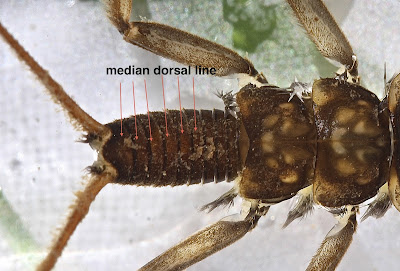When I found this stonefly on 11/14/13 in the Rivanna at Crofton, I regarded it as a form of Acroneuria abnormis. When I found it again on 9/1/14,
1. The pattern we see on the head is more in agreement with the description of A. evoluta than with that of A. arenosa.
A. arenosa: "dorsum of head with M-shaped pattern, sometimes faint to absent." (Beaty, "The Plecoptera of North Carolina," p. 14)
A. evoluta: "dorsum of head with interrupted M-shaped head pattern, appearing as a transverse row of 3 light spots in front of anterior ocellus." (Beaty, p. 14)
There is indeed "a transverse row of 3 light spots" on the head.
2. Beaty notes that this nymph "keys in Unzicker and McCaskill (1982) to A. mela." For this information, see Unzicker and McCaskill, "Plecoptera," Chapter 5 in Brigham, Brigham, and Gnilka, ed., Aquatic Insects and Oligochaetes of North and South Carolina, 1982. The description of A. mela is found on page 5.32. More important for us -- figure 5.87 on page 5.35 is an illustration of this Acroneuria species, and that illustration is a dead ringer for the nymphs I have found. (A. mela is now regarded as a synonym of A. evoluta.)
________________
And now for the evidence on the negative side. Again there are two arguments that we can make.
1. In his description of A. arenosa, Peter Claassen (Peter W. Claassen, Plecoptera Nymphs of America (North of Mexico), 1931. pp. 84-85) says the following about the abdominal segments: "Abdominal segments brownish, with a row of roundish, yellow spots along the median dorsal line, and with similar spots on the lateral margin of the posterior segments."
2. and in the photo of A. arenosa posted by Chandler (http://www.discoverlife.org/mp/20q?search=Acroneuria+arenosa) those yellow spots are clear. There are no yellow spots on the median dorsal line of the nymphs I have found.
I'd say we're finding A. evoluta. There is only one argument against this identification, and it's one I've noted before (9/4/14): A. evoluta is not attested in the state of Virginia according to NatureServe Explorer (http://explorer.natureserve.org/), nor is it verified as a Virginia Acroneuria by Stewart and Stark (Nymphs of North American Stonefly Genera, p. 316). But since we know it is found in the rivers of Pennsylvania, Tennessee, North Carolina and Georgia (Stewart and Stark), I don't see why it shouldn't be here.
________________
Additional photos:







No comments:
Post a Comment